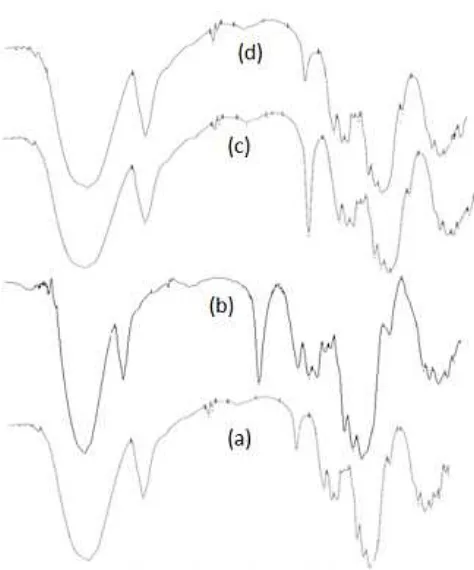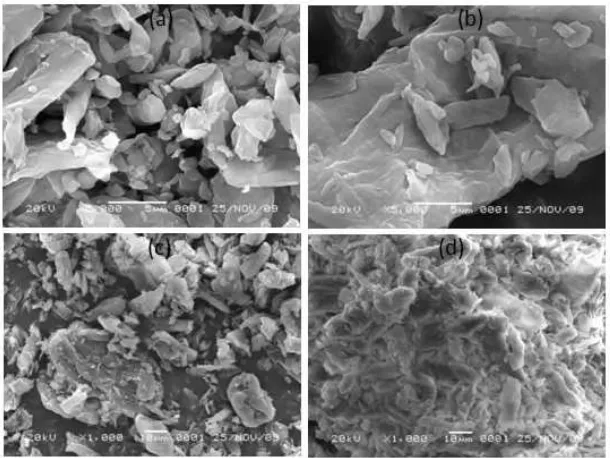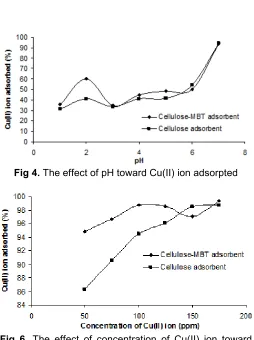SYNTHESIS, CHARACTERIZATION OF CELLULOSE
MODIFIED WITH 2-MERCAPTOBENZOTHIAZOLE AND ITS ADSORPTION
TO Cu(II) ION IN AQUEOUS SOLUTION
Ahmad Fatoni
1,*, Soerja Koesnarpadi
2, and Nurlisa Hidayati
31
School of Pharmacy Science Bhakti Pertiwi,
Jl. Ariodillah 3 No. 22 Palembang 30128 South Sumatera, Indonesia 2
Department of Chemistry, Faculty of Mathematics and Natural Sciences, Mulawarman University, Jl. Barong Tongkok No. 4 Kampus Gunung Kelua Samarinda 75123 East Kalimantan, Indonesia
3
Department of Chemistry, Faculty of Mathematics and Natural Sciences, Sriwijaya University, Jl. Palembang-Prabumulih Km. 32 Ogan Ilir South Sumatera, Indonesia
Received November 6, 2014; Accepted March 6, 2015
ABSTRACT
The modification of cellulose with 2-mercaptobenzhotiazole (MBT) through grafting and impregnating methods has been done. Modified cellulose used as adsorbent for Cu(II) ion in aqueous solution. The aims of research were modification cellulose with 3-chloropropyltrimethoxysilane and 2-mercaptobenzhotiazole (MBT), characterization of the modified cellulose with FTIR, SEM and XRD and adsorption study between cellulose-MBT adsorbent with Cu(II) ion in aqueous solution. The adsorbent of cellulose-MBT was synthesized by reflux process. Adsorption study between cellulose-MBT adsorbent with Cu(II) ion was investigated based on influence of pH solution, interaction time and initial concentration of Cu(II) ion. The result showed that activated cellulose can be modified with MBT to become cellulose-MBT adsorbent. The functional group of –C=N appeared at wavenumber 1658 cm-1attributed to functional group of -C=N- is Schiff base of MBT. Presence functional group of S-H at cellulose-MBT adsorbent was not detected. The surface morphology of cellulose-MBT adsorbent after being interacted with Cu(II) ion was different before being interacted with Cu(II) ion. The diffractogram of MBT adsorbent has similarity with cellulose-MBT adsorbent-Cu(II) ion. The optimum adsorption of Cu(II) ion was observed at pH 7.0 and 150 min of interaction time. Percentage of Cu(II) ion was absorbed by cellulose-MBT adsorbent tended to be constant after Cu(II) ion concentration 100 ppm.
Keywords:modified cellulose; MBT; Cu(II) in aqueous solution
ABSTRAK
Telah dilakukan modifikasi selulosa dengan senyawa organik melalui metode penempelan dan impregnasi. Selulosa termodifikasi kemudian digunakan sebagai adsorben ion Cu(II) dalam larutan berair. Tujuan dari penelitian ini adalah modifikasi selulosa dengan 3-kloropropiltrimetoksisilen dan 2-merkaptobenzotiazol (MBT), karakterisasi selulosa termodifikasi menggunakan FTIR, SEM, XRD dan studi adsorpsi antara adsorben selulosa-MBT dengan ion Cu(II) dalam larutan berair. Adsorben selulosa-MBT disintesis dengan proses refluks. Eksperimen adsorpsi antara adsorben selulosa-MBT dengan ion Cu(II) dipelajari berdasarkan pengaruh pH larutan, waktu interaksi dan konsentrasi ion Cu(II). Hasil penelitian menunjukkan bahwa selulosa teraktivasi dapat dimodifikasi dengan senyawa organik menjadi adsorben selulosa-MBT. Gugus fungsi –C=N yang merupakan Basa Schiff dari MBT muncul pada bilangan gelombang 1658 cm-1. Keberadaan gugus fungsional S-H adsorben yang berasal dari MBT tidak terdeteksi. Morfologi permukaan adsorben selulosa-MBT menunjukkan perbedaan antara sebelum dan sesudah adsorben diinteraksikan dengan ion Cu(II). Difraktogram adsorben selulosa-MBT memiliki kemiripan dengan adsorben selulosa-MBT-ion Cu(II). Ion Cu(II) yang teradsorpsi oleh adsorben selulosa-MBT mencapai optimum pada pH 7 dan waktu interaksi 150 menit. Persentase ion Cu(II) terserap oleh adsorben selulosa-MBT cenderung konstan setelah konsentrasi ion Cu(II) 100 ppm.
INTRODUCTION
The decrease of heavy metal or non heavy metal concentration in environment usually uses adsorption method. This method is effective to decrease heavy metal with simple processing [1]. Adsorption methods of metal ion can be done by using chemical or physical interactions [2]. Adsorption by physical interaction created by Van der Waals bond on surface of adsorbent whereas by chemical interaction occurred between adsorbed metal and adsorbent.
Modification of surface adsorbent is necessary to certain purpose. Modification of surface inorganic or organic materials with organic compound are expected to be able to give selective properties toward the metal ion, as a result, the adsorbent can be used for adsorption and preconcentration of certain metals and also to improve the adsorption and exchange properties [3-5].
Silane coupling agents can be interacted with organic material [6-7]. The organic material as cellulose was modified by silane coupling agents throughgrafting method. The grafting method is a simple technique to insert the active functional group [8]. The result of this modification has a purpose to increase the strength of interfacial cohesion and specific properties [9-10]. A little information was obtained which organic compounds as modified agent of organic material through grafting and impregnating methods. Modified organic material can be used for adsorption and preconcentration purpose of heavy metal ion [7,10-14].
Modification cellulose with 3-chloropropyltrimetoxy silane and 2-mercaptobenzothiazole (MBT) through grafting and impregnating method to form cellulose-MBT adsorbent which has S-H group and N atom. Sulphur and Nitrogen atom act as atom donor to form coordination covalent bond with metals [5,15-16]. Interaction between Cu(II) ion with cellulose-MBT adsorbent was studied by influence of solution pH, interaction time and the concentration of Cu(II) ion.
EXPERIMENTAL SECTION
Materials
Microcrystalline cellulose, 2-mercaptobenzo thiazole, ethyl alcohol (96%), dimethylformamide (DMF), HCl (37%), 3-chloropropyltrimetoxysilane and CuSO4.5H2O. All in analytical grade were purchased
from Merck except 3-chloropropyltrimetoxysilane from Aldrich.
Instrumentation
The instruments used for characterization included Fourier Transform Infrared (FTIR) spectrometer Shimadzu Prestige-21 for identifying the presence of functional groups. Scanning Electron Microscope (SEM) JSM-6360 LA for characterizing the morphology. Atomic Absorption Spectrophotometer (AAS) SHIMADZU AA 6200 for determining of remaining concentration of Cu and XRD Spectrophotometer Shimadzu XRD-6000 for evaluating the crystalline level of the adsorbent.
Procedure
Activation of cellulose and synthesis cellulose-MBT adsorbent [12]
Activation was carried out by heating cellulose on oven at 80 °C. A 30 g activated cellulose was mixed with 100 mL of DMF and this mixture was added with 15 mL of 3-chloropropyltrimetoxysilane and refluxed under continuous stirring for 5-16 h at 80 °C. The result from modification of cellulose above then was filtered and washed with ethyl alcohol 96%. The product was dried in the oven at 75 °C for 1-4 h.
A 10 g of dry cellulose-3-chloropropyldimethoxy silane was added by 100 mL of DMF solution and reacted with 15 mL of 2-mercapthobenzothiazole 10% (w/v). This mixture was shaked by stirrer for 3-5 h at room temperature. Mixture was filtered and washed with DMF and ethyl alcohol 96% then dried in the oven at 75 °C. The product was named cellulose-MBT adsorbent.
The functional group, morphology and physical structure analysis
Characterization functional group of cellulose before and after modification using FTIR Spectrophotometer. The morphology and physical structure analysis of activated cellulose and modified cellulose are using SEM and XRD, respectively.
Adsorption experiments
Fig 1.The Spectra FT. IR (a). cellulose, (b). Cellulose-3-chloropropyldimethoxysilane. (c). -Cellulose-3-chloro propyldimethoxysilane-MBT (cellulose-MBT) and (d). Cellulose-MBT-Cu(II) ion
Erlenmeyer flask containing 10 mL Cu(II) ion solutions. The flask was shaken mechanically for 1 to 150 min. The solution pH was in range 1 to 7. The Cu(II) ion concentrations in the experiments were in range 50 to 175 ppm. The mixture was filtered and concentration of supernatant containing Cu(II) ion was determined by using Atomic Absorption Spectrophotometer (AAS) as the remaining concentration.
RESULT AND DISCUSSION
Modification of Cellulose-MBT Adsorbent
The aim of the activation cellulose was to remove water content in cellulose so cellulose surfaces can be reacted directly through hydroxyl group [10,17-19]. Modification of cellulose surface can be done by covalent grafting through immobilization silane reagent. The active functional group of hydroxyl in C5 from
primary alcohol (-CH2OH) at cellulose monomer have an
ability to react with organic ligand [12]. The hydroxyl group from -CH2OH can be reacted with organosilil
group of 3-chloropropyltrimetoxysilane to form cellulose-3-chloropropyldimethoxysilane. Reaction 2-mercapto benzothiazole (MBT) with cellulose-3-chloropropyl
dimethoxysilane occurred through Cl atom of silane with H atom derived from MBT. The result of whole reaction was named cellulose-MBT adsorbent.
Presence of Functional Group
The FTIR spectra of activated cellulose and modified cellulose are shown in Fig. 1. A broad absorption band which corresponds to stretching vibrations of OH functional group from cellulose can be observed at wavenumber 3348 cm-1. Absorption band observed at 2900 cm-1 is due to the C-H vibration stretch of –CH2group from primary alcohols. A peak at
1157 and 1111 cm-1were the asymmetric stretching vibrations of C-O-C. The functional group of C-O-H (bending vibrations) appeared at wavenumber 1427 cm-1. The functional group of C-O was the primary alcohol of activated cellulose appeared at 1056 cm-1. A glycoside linkages was assigned by appeared of the absorption band at 894 cm-1 [7] and the functional group of C-C were the bending vibrations appeared very weak at peak 493 and 401 cm-1[20].
The FT.IR spectrum from cellulose-3-chloro propyldimethoxysilane was assigned by the adsorption band at 1276 and 1244 cm-1 attributed to functional group of CH2Cl [20]. The peak at 830-1110 cm-1are the
functional group Si-O [20] and the peak at 898 cm-1is the functional group Si-O-C symmetric stretching [7] from cellulose 3-chloropropyldimethoxysilane.
The spectra FT.IR from cellulose-3-chloropropyl dimethoxysilane-MBT was not assigned by the functional group of S-H from MBT (the adsorption band 2600-2550 cm-1). The vibration of the functional group of S-H is weak at IR region [21]. The functional group of –C=N (stretching vibration) appeared at wave number 1658 cm-1 attributed to functional group of -C=N- is Schiff base of MBT and usually more intense than the –C=C- stretch [20].
The spectra FT.IR from cellulose-MBT adsorbent interacted with Cu(II) ion was assigned by intensity decrease of the functional group of –C=N- after being interacted with Cu(II) ion. The appearance peak at 447 cm-1 attributed to stretching vibration of N atom with metal [22]. This fact showed that Cu(II) ion may be interacted with N atom from –N=C- of MBT, whereas interaction between Cu(II) ion with S atom from MBT was not detected.
Adsorbent Characterization
SEM
Fig 2. SEM Image: (a). cellulose, (b). Cellulose-3-chloropropyldimethoxysilane (c). -Cellulose3-chloropropyl dimethoxysilane-MBT (cellulose-MBT) and (d). Cellulose-MBT-Cu(II) ion.
Fig 3. XRD patterns: (a). cellulose, (b). Cellulose-3-chloropropyldimethoxysilane (c). –Cellulose-3-chloropro pyldimethoxysilane-MBT (cellulose-MBT) and (d). Cellulose-MBT-Cu(II) ion
morphology of activated cellulose (Fig. 2a) shows irregular fiber fragments or irregular shaped fibrils and
has a network structure [23-24] but after interacted with 3-chloropropyltrimethoxysilane appeared obviously diverse (Fig. 2b). Fig. 2c is cellulose- 3-chloropropyl dimethoxysilane after reacting with MBT has similar surface morphology to Fig. 2a. There is difference between Fig. 2a and 2c caused disappearance of cross-linking of cellulose [25]. Fig. 2d shows surface morphology of cellulose-MBT adsorbent after adsorbed Cu(II) ion. It has obviously diversification toward Fig. 2c.
XRD
The physical structure of activated cellulose, cellulose- 3-chloropropyldimethoxysilane, cellulose-3-chloropropyldimethoxysilane-MBT (cellulose-MBT) and cellulose-MBT-Cu(II) are shown in Fig. 3. Fig. 3a shows that activated cellulose is crystalline form. It has three
strong peaks at 2θ = 14.73, 22.45 and 34.52. These
peaks are the characteristics of cellulose [7,26]. Modification activated cellulose with 3-chloropropyl trimethoxysilane and MBT as the adsorbent for Cu(II) ion were not alternated crystalline form (Fig. 3b, c and d).
Fig 4.The effect of pH toward Cu(II) ion adsorpted
Fig 5. The effect of interaction time toward Cu(II) ion adsorpted
Fig 6. The effect of concentration of Cu(II) ion toward Cu(II) ion adsorpted
Interaction between Cu(II) Ion with Cellulose-MBT Adsorbent
The effect of pH
The effect of pH toward the adsorption Cu(II) ion to active site cellulose-MBT and activated cellulose adsorbent are shown in Fig. 4 where at pH 7 Cu(II) ion adsorbed reached up to 93.83 and 94.28%, respectively. The increase of pH will improve the adsorbed metal (Cu(II) ion) at active site cellulose-MBT and activated cellulose adsorbent. At lower pH values, the H+ ions compete with the metal ions for the exching sites in the adsorbent and the binding of Cu(II) ion with active site on the adsorbent surface was very low. When the pH increases, the concentration H+ ions decreases, the binding of Cu(II) ion with active site on the adsorbent surface was very high [28]. The percentage of Cu(II) ion adsorbed at active site on activated cellulose adsorbent surface at pH 7 has a similarity with cellulose-MBT adsorbent. This was due to the fact that at pH 7, the adsorbent has reached a stable maximum binding capability as reported by Yin et al. [25] and Aydin et al. [28].
The effect of interaction time
The interaction time experiments were carried out at pH 7. The dependence of adsorption of Cu(II) ion with interaction time is presented in Fig. 5. The adsorption Cu(II) ion at active site cellulose-MBT adsorbent increased with increasing interaction time. The percentage of Cu(II) ion adsorbed on active site cellulose-MBT adsorbent was 96.71% at interaction time 150 min.
On the other hand, the percentage of Cu(II) ion adsorbed on active site activated cellulose adsorbent was 95.25% at interaction time 150 min. At interaction time 1 min and 150 min, the percentage of Cu(II) ion adsorbed on active site activated cellulose adsorbent tends similar. This phenomenon showed that interaction time 1 min (the shortest of interaction time) active site CH2-OH from activated cellulose adsorbent
has reached equilibrium and the dominant mechanism reaction was chemisorptions [29]. The reason for cellulose-MBT adsorbent that not constant after interaction time 150 min and activated cellulose adsorbent has disorder data after shortest of interaction time are due to the experimental mistake.
The effect of the concentration Cu(II) ion
The effect of MBT addition at activated cellulose Data from adsorption experiment showed that addition of MBT does not change significant of the adsorption capability. This case based on the binding of –N=CH- and S at active site cellulose-MBT adsorbent are soft donor according to HSAB theory (Hard and Soft Acids Bases theory). If the binding of –N=CH- and S are soft base and can act as soft donor atom, N and S atom are a tend to bind with soft acid than border line (Cu(II) ion) and hard acid [32]. Active sites at activated cellulose are carbonyl (C=O) or hydroxyl groups (OH) and considered a strong Lewis base [28]. This result confirm, that the percentage Cu(II) ion adsorbed by active site cellulose-MBT and activated cellulose adsorbent were equal, because interaction between N and S atom (soft base) at active site of cellulose-MBT and carbonyl (C=O) or hydroxyl groups (OH) (hard base) at active site activated cellulose adsorbent are less disfavor with Cu(II) ion (border line acid) according HSAB theory.
CONCLUSION
Cellulose-MBT adsorbent was resulted by reaction between cellulose, 3-chloropropyltrimetoxysilane and 2-mercaptobenzothiazole (MBT). Presence of functional group of S-H at cellulose-MBT adsorbent was not detected. The morphology of surface cellulose-MBT adsorbent after being interacted with Cu(II) ion was different before being interacted with Cu(II) ion. The diffractogram of cellulose-MBT adsorbent has similarity with cellulose-MBT adsorbent-Cu(II) ion. The effect of pH and interaction time toward the adsorption of Cu(II) ion by cellulose-MBT adsorbent indicated that Cu(II) ion adsorbed by cellulose-MBT adsorbent reached 96.71% at interaction time 150 min and pH 7. The effect of concentration of Cu(II) ion adsorbed by cellulose-MBT adsorbent reached the maximum at 100 ppm.
ACKNOWLEDGEMENT
We are thankful to DP2M DIKTI KEMENDIKNAS RI for providing financial support to this research with contract number: 424/SP2H/PP/DP2M/VI/2009 and thanks to Imron Hafid, undergraduate students of Chemistry Department, Faculty of Mathematics and Natural Sciences Mulawarman University Samarinda for his valuable help in the part of this research.
REFERENCES
1. Filho, N.C., Venancio, E.C., Barriquello, M.F., Hechenleitner, A.A.W., and , Pineda, E.A.G., 2007, Ecletica Quim., 32(4), 63–70.
2. Kumar, P.S., and Kirthika, K., 2009, J. Eng. Sci. Technol., 4(4), 351–363.
3. Fatoni, A., Koesnarpadi, S., and Hidayati, N., 2010, Indones. J. Chem., 10(3), 315–319.
4. Dey, R.K., Jha, U., Singh, A.C., and Ray Alok R., 2006,Anal. Sci., 22, 1105–1110.
5. Budiman, H., Sri, H.K.F., and Setiawan, A.H., 2009,Electron. J. Chem., 6(1), 141–150.
6. Domka, L., Krysztafkiewicz, A., and Kozak, M., 2002,Polym.Polym. Compos.,10(7), 541–552. 7. Singh, K., and Srivastava, S., 2014,Indian. J. Appl.
Res., 4(9), 518–520.
8. Nada, A.A.M.A., Alkady, M.Y., and Fekry, H.M., 2007,BioResources, 3(1), 46–59.
9. Rachini, A., Le Troedec, M., Peyratout, C., and Smith, A., 2012, J. Appl. Polym. Sci., 123(1), 601–610.
10. Rangel-Vásques, N.A., and Leal-Garcia, T., 2010, J. Mex. Chem. Soc., 54(4), 192–197.
11. Liu, P., 2007,Turk. J. Chem., 31, 457–462.
12. de Castro, G.R., de Alcântara, I.L., Roldan, P.S., Bozano, D.F., Padilha, P.M., Florentino, A.O., and Rocha, J.C.,2004,Mater. Res., 7(2), 329–334. 13. Fatoni, A.; Koesnarpadi, S dan Hidayati, N., 2010,
Sintesis, Karakterisasi dan Aplikasi Adsorben Selulosa Termodifikasi Asam Merkaptoasetat Sebagai adsorben Logam Krom, Prosiding Seminar Nasional Kimia dan Pendidikan Kimia II, UNS, Solo.
14. Thakur, M.K., Gupta, R.K., and Thakur, V.K., 2014, Carbohydr. Polym., 111, 849–855.
15. Filho, N.L.D., do Carmo, D.R., Gressner, F., and Rosa, A.H, 2005,Anal. Sci., 21(11), 1309–1316. 16. Filho, N.L.D., do Carmo, D.R., Caetano, L., and
Rosa, A.H., 2005,Anal. Sci., 21(11), 1359–1363. 17. Hubbe, M.A., Rojas, O.J., Lucia, L.A., and Sain, M.,
2008,BioResources, 3(3), 929–980.
18. Kuruvilla, J., Thomast, S., and Pavithran, C., 1996, Polymer, 37(23), 5139–5149.
19. Le Moigne, N., Longerey, M., Taulemesse, J.M., Bénézet, J.C., and Bergeret, A., 2014, Ind. Crops Prod., 52, 481–494.
20. Silverstein, R.M., Bassler, G.C., and Morril, C.T., 1991, Spectrometric Identification of Organic Compounds, 5th ed., John Wiley and Sons Inc., New York.
21. Nuryono, Nuzula, F., and Narsito, 2008, Alchemy, 7(1), 1–8.
22. Bagihalli, G.B., Patil, S.A., and Badami, P.S., 2009, J. Iran. Chem. Soc., 6(2), 259–270.
23. Adel, A.M., El-Wahab, Z.H.A., Ibrahim, A.A., and Al-Shemy, M.T., 2011, Carbohydr. Polym., 83(2), 676–687.
25. Yin, Q.F., Ju, B.Z., Zhang, S.F., Wang, X.B., and Yang, J.Z. 2008. Carbohydr. Polym., 72(2), 326–333.
26. Zhang, K., Peschel, D., Bäucker, E., Groth, T., and Fischer, G., 2011, Carbohydr. Polym., 83(4), 1659–1664.
27. Park, S., Baker, J.O., Himmel, M.E., Parilla, P.A., and Johnson, D.K., 2010,Biotechnol. Biofuels, 3(1), 1–10.
28. Aydin, H., Bulut, Y., and Yerlikaya, C., 2008, J. Environ. Manage., 87(1), 37–45.
29. Wankasi, D., Harsfall Jr.M., and Spiff, A.I., 2006, Electron. J. Biotechol., 9(5), 587–592.
30. Santosa, S.J., Sudiono, S., and Sujandi, S., 2006, e-J. Surf. Sci. Nanotechnol., 4, 602–608.
31. Daneshfozoun, S., Nazir, M.S., Abdullah, B., and Abdullah, M., 2014, Chem. Eng. Trans., 37, 679–684.


